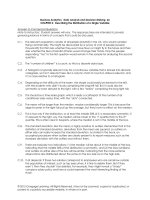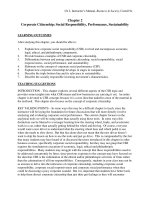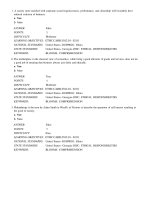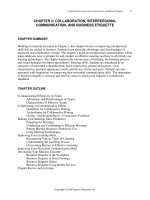Test bank and solution of business statitics a first course 6e by levine (2)
Bạn đang xem bản rút gọn của tài liệu. Xem và tải ngay bản đầy đủ của tài liệu tại đây (2.83 MB, 105 trang )
108 Chapter 2: Organizing and Visualizing Data
CHAPTER 2
2.1
The answer depends on the chosen data set.
2.2
The answer depends on the specific story.
2.3
The supermarket chain should use primary data collected through an observation study of the
shopping behavior of their customers.
2.4
The information presented there is based on surveys.
2.5
(a)
(b)
2.6
(a)
(b)
Category
Frequency
A
13
B
28
C
9
Category “B” is the majority.
Percentage
26%
56
18
Table frequencies for all student responses
Student Major Categories
Gender A
C
M
Totals
Male 14
9
2
25
Female 6
6
3
15
Totals 20
15
5
40
Table percentages based on overall student responses
Student Major Categories
Gender A
C
M
Totals
Male 35.0% 22.5% 5.0% 62.5%
Female 15.0% 15.0% 7.5% 37.5%
Totals 50.0% 37.5% 12.5% 100.0%
Table based on row percentages
Student Major Categories
Gender A
C
M
Totals
Male 56.0% 36.0% 8.0% 100.0%
Female 40.0% 40.0% 20.0% 100.0%
Totals 50.0% 37.5% 12.5% 100.0%
Table based on column percentages
Student Major Categories
Gender A
C
M
Totals
Male
70.0% 60.0% 40.0% 62.5%
Female 30.0% 40.0% 60.0% 37.5%
Totals 100.0% 100.0% 100.0% 100.0%
Solutions to End-of-Section and Chapter Review Problems
2.7
109
(a)
Category
Frequency
Percentage
Flammables/Irritants
8,350
59.26%
Knives and blades
4,134
29.34%
Prohibited tools
753
5.34%
Sharp objects
497
3.53%
Other
357
2.53%
Total
(b)
2.8
14,091
100.00%
Flammables, irritants, knives and blades made up almost 90% of the banned items.
(a)
Region
Developed Europe
Japan
United States
Rest of the world
Total
(b)
2.9
Oil Consumption
Percentage
(millions of barrels a day)
14.5
17.18%
4.4
5.21%
18.8
22.27%
46.7
55.33%
84.4
100.00%
More than half the oil consumed is from countries other than the U.S., Japan, and
developed Europe. More than 20% is consumed by the U.S. and slightly less than
20% is consumed by developed Europe.
(a)
(b)
Category
Cost per Household
Percentage
Civil servant retirement
15,851
2.90%
Federal debt
54,537
9.97%
Medicare
284,288
52.00%
Military retirement
29,694
5.43%
Social Security
160,216
29.30%
Other
2,172
0.40%
Total
546,758
100.00%
Medicare at 52% and Social Security at 29.3% together made up more than 80% of
the debt.
110 Chapter 2: Organizing and Visualizing Data
2.10
(a)
Table of total percentages
ENJOY SHOPPING FOR
CLOTHING FOR YOURSELF
GENDER
Male
Female
Total
22%
25%
47%
28%
25%
53%
50%
50%
100%
Yes
No
Total
Table of row percentages
ENJOY SHOPPING FOR
CLOTHING FOR YOURSELF
GENDER
Male
Female
Total
46%
54%
100%
53%
47%
100%
50%
50%
100%
Yes
No
Total
Table of column percentages
ENJOY SHOPPING FOR
CLOTHING FOR YOURSELF
Male
Female
Total
44%
51%
47%
56%
49%
53%
100%
100%
100%
Yes
No
Total
(b)
2.11
GENDER
A higher percentage of females enjoy shopping for clothing for themselves.
(a)
Table of total percentages
Nonconforming
Conforming
Total
Shift
Day
Evening
1.6%
2.4%
65.4% 30.6%
67%
33%
4%
96%
100%
Table of row percentages
Shift
Day Evening
Nonconforming 40%
60% 100%
Conforming
68%
32% 100%
Total
67%
33% 100%
Table of column percentages
Shift
Day Evening
Nonconforming
2%
7%
Conforming
98%
93%
Total
100% 100%
4%
96%
100%
Solutions to End-of-Section and Chapter Review Problems
2.11
cont.
(b)
(c)
2.12
111
The row percentages allow us to block the effect of disproportionate group size and
show us that the pattern for day and evening tests among the nonconforming group is
very different from the pattern for day and evening tests among the conforming group.
Where 40% of the nonconforming group was tested during the day, 68% of the
conforming group was tested during the day.
The director of the lab may be able to cut the number of nonconforming tests by
reducing the number of tests run in the evening, when there is a higher percent of
tests run improperly.
Table of row percentages
Year
Need => 3 Clicks
Yes No
2009 39%
61% 100%
2008 7%
93% 100%
67%
33%
row percentages
table,100%
32%
Total
According
to the
more clicks in 2009 than in 2008.
more online retailers were requiring three or
2.13
Ordered array: 63 64 68 71 75 88 94
2.14
Ordered array: 73 78 78 78 85 88 91
2.15
(a)
4%
2.16
(a)
The class boundaries of the 9 classes can be "10 to less than 20", "20 to less than 30",
"30 to less than 40", "40 to less than 50", "50 to less than 60", "60 to less than 70",
"70 to less than 80", "80 to less than 90", and "90 to less than 100".
(b)
The class-interval width is
(c)
The nine class midpoints are: 15, 25, 35, 45, 55, 65, 75, 85, and 95.
(a)
Ordered array: Cost($)115, 121, 127, 132, 141, 151, 158, 160, 161, 162, 168, 170,
172, 173, 178, 180, 184, 207, 208, 212, 216, 217, 221, 222, 227, 227, 250, 316, 330,
335
PHStat output:
2.17
(b)
(b) 32%
Bin Cell
105 but less than 135
135 but less than 165
165 but less than 195
195 but less than 225
225 but less than 255
255 but less than 285
285 but less than 315
315 but less than 345
(c)
(c) 36%
(d) 100%
97.8 11.6
9.58 10 .
9
Frequency
4
6
7
7
3
0
0
3
Percentage
13.33%
20.00%
23.33%
23.33%
10.00%
0.00%
0.00%
10.00%
The costs of attending a baseball game is concentrating around $195 for
fourteen of the teams have costs in between $165 and $225.
112 Chapter 2: Organizing and Visualizing Data
2.18
(a)
Electricity Costs
$80 to $99
$100 to $119
$120 to $139
$140 to $159
$160 to $179
$180 to $199
$200 to $219
Frequency
4
7
9
13
9
5
3
Percentage
8%
14
18
26
18
10
6
(b)
Electricity Costs
$99
$119
$139
$159
$179
$199
$219
(c)
2.19
Frequency
4
7
9
13
9
5
3
Percentage
8%
14%
18%
26%
18%
10%
6%
Cumulative %
8%
22%
40%
66%
84%
94%
100%
The majority of utility charges are clustered between $120 and $180.
(a), (b)
Bin
Frequency Percentage Cumulative %
-0.00350 but less than -0.00201
13
13.00%
13.00%
-0.00200 but less than -0.00051
26
26.00%
39.00%
-0.00050 but less than 0.00099
32
32.00%
71.00%
0.00100 but less than 0.00249
20
20.00%
91.00%
0.00250 but less than 0.00399
8
8.00%
99.00%
0.004 but less than 0.00549
1
1.00%
100.00%
(c)
2.20
Yes, the steel mill is doing a good job at meeting the requirement as there is only one
steel part out of a sample of 100 that is as much as 0.005 inches longer than the
specified requirement.
(a), (b)
Bin
(c)
Frequency
Percentage
Cumulative %
8.310 -- 8.329
3
6.12%
6.12%
8.330 -- 8.349
2
4.08%
10.20%
8.350 -- 8.369
1
2.04%
12.24%
8.370 -- 8.389
4
8.16%
20.41%
8.390 -- 8.409
5
10.20%
30.61%
8.410 -- 8.429
16
32.65%
63.26%
8.430 -- 8.449
5
10.20%
73.46%
8.450 -- 8.469
5
10.20%
83.66%
8.470 -- 8.489
6
12.24%
95.90%
8.490 -- 8.509
2
4.08%
100.00%
All the troughs will meet the company’s requirements of between 8.31 and 8.61
inches wide.
Solutions to End-of-Section and Chapter Review Problems
2.21
(a),(b)
Strength
(c)
2.22
113
Frequency
Percentage
Cumulative Percentage
1500 -- 1549
1550 -- 1599
1
2
3.33%
6.67%
3.33%
10.00%
1600 -- 1649
1650 -- 1699
2
7
6.67%
23.33%
16.67%
40.00%
1700 -- 1749
1750 -- 1799
5
7
16.67%
23.33%
56.67%
80.00%
1800 -- 1849
1850 -- 1899
3
3
10.00%
10.00%
90.00%
100.00%
The strength of all the insulators meets the company’s requirement of at least 1500
lbs.
(a)
Bulb Life (hrs)
650 -- 749
750 -- 849
850 -- 949
950 -- 1049
1050 -- 1149
Frequency
Manufacturer A
3
5
20
9
3
Bulb Life (hrs)
750 -- 849
850 -- 949
950 -- 1049
1050 -- 1149
1150 -- 1249
Frequency
Manufacturer B
2
8
16
9
5
(a), (b)
Bulb Life (hrs)
650 – 749
750 – 849
850 – 949
(c)
A
Percentage Cumulative %
7.50%
7.50%
12.50%
20.00%
50.00%
70.00%
B
Percentage Cumulative %
.00%
0.00%
5.00%
5.00%
20.00%
25.00%
950 – 1049
1050 – 1149
22.50%
7.50%
92.50%
100.00%
40.00%
22.50%
65.00%
87.50%
1150 – 1249
0.00%
100.00%
12.50%
100.00%
Manufacturer B produces bulbs with longer lives than Manufacturer A. The
cumulative percentage for Manufacturer B shows 65% of its bulbs lasted less than
1,050 hours, contrasted with 70% of Manufacturer A’s bulbs, which lasted less than
950 hours. None of Manufacturer A’s bulbs lasted more than 1,149 hours, but 12.5%
of Manufacturer B’s bulbs lasted between 1,150 and 1,249 hours. At the same time,
7.5% of Manufacturer A’s bulbs lasted less than 750 hours, whereas all of
Manufacturer B’s bulbs lasted at least 750 hours
114 Chapter 2: Organizing and Visualizing Data
(a)
(b)
2.24
Amount of
Soft Drink
Frequency
Percentage
1.850 – 1.899
1
2%
1.900 – 1.949
5
10
1.950 – 1.999
18
36
2.000 – 2.049
19
38
2.050 – 2.099
6
12
2.100 – 2.149
1
2
Amount of
Frequency
Percentage
Soft Drink
Less Than
Less Than
1.899
1
2%
1.949
6
12
1.999
24
48
2.049
43
86
2.099
49
98
2.149
50
100
The amount of soft drink filled in the two liter bottles is most concentrated in two
intervals on either side of the two-liter mark, from 1.950 to 1.999 and from 2.000 to
2.049 liters. Almost three-fourths of the 50 bottles sampled contained between 1.950
liters and 2.049 liters.
(a) Note: %s converted to counts. n = 1264
Bar Chart
Salespeople
Retail websites
Shopping Advisers
2.23
Other
Online user reviews
News media
Manufacturer websites
Friends/family
Advertising
0
100
200
300
400
500
600
Solutions to End-of-Section and Chapter Review Problems
(a)
Pie Chart
Salespeople
Retail websites 1%
Advertising
4%
7%
Other
14%
Online user
reviews
13%
Friends/family
45%
News media
11%
Manufacturer
websites
5%
Pareto Diagram
Salespeople
Retail websites
Manufacturer
websites
Advertising
News media
Online user reviews
100%
90%
80%
70%
60%
50%
40%
30%
20%
10%
0%
Other
50%
45%
40%
35%
30%
25%
20%
15%
10%
5%
0%
Friends/family
2.24
cont.
115
Shopping Advisers
(b)
(c)
The Pareto diagram is better than the pie chart to portray these data because it not
only sorts the frequencies in descending order, it also provides the cumulative
polygon on the same scale.
You can conclude that friends/family account for the largest percentage of 45%.
When other, news media, and online user reviews are added to friends/family, this
accounts for 83%.
116 Chapter 2: Organizing and Visualizing Data
(a)
Bar Chart
Working, volunteering,
student clubs
Studying
Activity
Socializing, recreating, other
Sleeping
Attending class/lab
0
500 1000 1500 2000
Counts
Pie Chart
Working,
volunteering,
student clubs
9%
Attending
class/lab
9%
Studying
7%
Sleeping
24%
Socializing,
recreating,
other
51%
Pareto Diagram
60%
100%
90%
80%
70%
60%
50%
40%
30%
20%
10%
0%
50%
40%
30%
20%
10%
Studying
Working, volunteering,
student clubs
Attending class/lab
Sleeping
0%
Socializing, recreating,
other
2.25
Activity
(b)
(c)
The Pareto diagram is better than the pie chart or the bar chart because it not only
sorts the frequencies in descending order, it also provides the cumulative polygon on
the same scale.
From the Pareto diagram, it is obvious that slightly more than 50% of them were
socializing, recreating or performing other activities.
Solutions to End-of-Section and Chapter Review Problems
2.26
117
(a)
(b)
According to the Pareto chart, slightly less than 90% of the power is derived from
coal, nuclear, or natural gas.
(c)
(d)
You will prefer using the Pareto chart over the pie chart because the Pareto chart not
only sorts the frequencies in descending order, it also provides the cumulative
polygon on the same scale.
118 Chapter 2: Organizing and Visualizing Data
2.27
(a)
(b)
The bar chart is more suitable if the purpose is to compare the categories. The pie
chart is more suitable if the main objective is to investigate the portion of the whole
that is in a particular category. *
* Note: This is one of the many possible solutions for the question.
Solutions to End-of-Section and Chapter Review Problems
2.27
cont.
(c)
(d)
2.28
119
(a)
The “vital few” reasons for the causes of mistakes are “Quality assurance flawed”,
“Data entry or calculation errors by personnel”, and “Misidentification of patient or
treatment location” which account for more than 60% of the mistakes. The
remaining causes are the “trivial many” which make up less than 40% of the
mistakes.
120 Chapter 2: Organizing and Visualizing Data
2.28
cont.
(a)
(b)
(c)
The Pareto diagram is better than the pie chart and bar chart because it not only sorts
the frequencies in descending order, it also provides the cumulative polygon on the
same scale.
Almost 60% of the residential electricity consumption in the United States is on
“Clothes washers/other”, “Air conditioning”, and “Lighting”.
Solutions to End-of-Section and Chapter Review Problems
2.29
121
(a)
(b)
(c)
The Pareto diagram is better than the pie chart because it not only sorts the
frequencies in descending order, it also provides the cumulative polygon on the same
scale.
From the Pareto chart, beef, chicken and seafood make up 80% of what folks want
sizzling on the grill during barbecue season.
122 Chapter 2: Organizing and Visualizing Data
2.30
(a)
GENDER
Side-by-side Bar Chart
Female
No
Yes
Male
0
(b)
2.31
The director of the lab may be able to cut the number of nonconforming tests by
reducing the number of tests run in the evening, when there is a higher percent of
tests run improperly.
(a)
(b)
2.33
400
(a)
(b)
2.32
200
A higher percentage of females enjoy shopping for clothing.
32% more online retailers were requiring three or more clicks in 2009 than in 2008.
Stem-and-leaf of Finance Scores
5
34
6
9
7
4
9
38
Solutions to End-of-Section and Chapter Review Problems
2.34
Ordered array: 50 74 74 76 81 89 92
2.35
(a)
(b)
(c)
(d)
2.36
Ordered array: 9.1 9.4 9.7 10.0 10.2 10.2 10.3 10.8 11.1 11.2
11.5 11.5 11.6 11.6 11.7 11.7 11.7 12.2 12.2 12.3
12.4 12.8 12.9 13.0 13.2
The stem-and-leaf display conveys more information than the ordered array. We can
more readily determine the arrangement of the data from the stem-and-leaf display
than we can from the ordered array. We can also obtain a sense of the distribution of
the data from the stem-and-leaf display.
The most likely gasoline purchase is between 11 and 11.7 gallons.
Yes, the third row is the most frequently occurring stem in the display and it is located in
the center of the distribution.
(a)
Stem-and-Leaf
Display
Stem
unit:
Statistics
Sample Size
30
Mean
194.7
Median
179
Std.
56.8210
Deviation
4
Minimum
115
Maximum
335
(b)
123
10
11
12
13
14
15
5
17
2
1
18
16
17
18
19
20
21
22
23
24
25
26
27
28
29
30
31
32
33
0128
0238
04
78
267
1277
0
6
05
The results are concentrated between $160 and $227.
124 Chapter 2: Organizing and Visualizing Data
2.37
(a)
Ordered array: Cost($) 0.55, 0.57, 0.57, 0.68, 0.72, 0.77, 0.86, 0.90, 0.92, 0.94, 1.14,
1.41, 1.42, 1.51
(b)
Stem-and-Leaf
Display
Stem
0.1
unit:
5 577
6 8
7 27
8 6
9 024
10
11 4
12
13
14 1 2
15 1
(c)
(d)
(a)
Histogram
14
12
Frequency
2.38
The stem-and-leaf display conveys more information than the ordered array. We can
more readily determine the arrangement of the data from the stem-and-leaf display
than we can from the ordered array. We can also obtain a sense of the distribution of
the data from the stem-and-leaf display.
The cost does not appear to be concentrated around any value.
10
8
6
4
2
0
90
110
130
150
170
190
210
Midpoints
Percentage Polygon
30%
25%
20%
15%
10%
5%
0%
70
90
110
130
150
170
190
210
230
Solutions to End-of-Section and Chapter Review Problems
2.38
cont.
125
(b)
Cumulative Percentage Polygon
100%
90%
80%
70%
60%
50%
40%
30%
20%
10%
0%
79
(c)
99
119
139
159
179
199
219
239
The majority of utility charges are clustered between $120 and $180.
2.39
The costs of attending a baseball game is concentrating around $160 for nine of the teams.
Six teams have costs centered around $220. There are a few outliers in the right tail with one
team having a cost higher than $410.
2.40
The property taxes per capita appear to be right-skewed with approximately 90% falling
between $399 and $1,700, and the remaining 10% fall between $1,700 and $2,100. The
center is at about $1,000.
2.41
(a)
%
Histogram
35.00%
30.00%
25.00%
20.00%
15.00%
10.00%
5.00%
0.00%
0.0047
0.0032
0.0017
0.0002
-0.0013
-0.0028
---
Midpoints
(b)
Yes, the steel mill is doing a good job at meeting the requirement as there is only one
steel part out of a sample of 100 that is as much as 0.005 inches longer than the
specified requirement.
126 Chapter 2: Organizing and Visualizing Data
(a)
Histogram
Frequency
2.42
20
15
10
5
0
8.52
8.5
8.48
8.46
8.44
8.42
8.4
8.38
8.36
8.34
8.32
--Midpoints
Percentage Polygon
35%
30%
25%
20%
15%
10%
5%
0%
--- 8.32 8.34 8.36 8.38 8.4 8.42 8.44 8.46 8.48 8.5 8.52
(b)
Cumulative Percentage Polygon
120%
100%
80%
60%
40%
20%
0%
8.5299
8.5099
8.4899
8.4699
8.4499
8.4299
8.4099
8.3899
8.3699
8.3499
8.3299
8.3099
(c)
All the troughs will meet the company’s requirements of between 8.31 and 8.61
inches wide.
Solutions to End-of-Section and Chapter Review Problems
(a)
%Histogram
25.00%
20.00%
15.00%
10.00%
5.00%
0.00%
1525 1575 1625 1675 1725 1775 1825 1875
Midpoints
Percentage Polygon
25%
20%
15%
10%
5%
1925
1875
1825
1775
1725
1675
1625
1575
1525
1475
0%
(b)
Cumulative Percentage Polygon
100%
90%
80%
70%
60%
50%
40%
30%
20%
10%
(c)
1949
1899
1849
1799
1749
1699
1649
1599
1549
1499
0%
1449
2.43
127
The strength of all the insulators meets the company’s requirement of at least 1500
lbs.
128 Chapter 2: Organizing and Visualizing Data
(a)
Percentage
Percentage Histogram (Manufacturer A)
60
50
40
30
20
10
0
749
849
949
1049
1149
1249
Bin
Percentage Histogram (Manufacturer B)
Percentage
50
40
30
20
10
0
749
849
949
1049
1149
1249
Bin
Percentage
Percentage Polygon
60
50
40
30
20
10
0
Manufacturer A
Manufacturer B
600 700 800 900 1000 1100 1200
Mid-points
(b)
Ogives
100
80
60
Manufacturer A
40
Manufacturer B
20
Life (Hours)
1250
1150
1050
950
850
750
0
650
Percentage
2.44
Solutions to End-of-Section and Chapter Review Problems
2.44
cont.
(c)
2.45
(a)
(b)
129
Manufacturer B produces bulbs with longer lives than Manufacturer A. The
cumulative percentage for Manufacturer B shows 65% of their bulbs lasted 1049
hours or less contrasted with 70% of Manufacturer A’s bulbs which lasted 949 hours
or less. None of Manufacturer A’s bulbs lasted more than 1149 hours, but 12.5% of
Manufacturer B’s bulbs lasted between 1150 and 1249 hours. At the same time, 7.5%
of Manufacturer A’s bulbs lasted less than 750 hours, while all of Manufacturer B’s
bulbs lasted at least 750 hours.
Amount of
Soft Drink
1.899
1.949
1.999
2.049
2.099
2.149
Frequency
Less Than
1
6
24
43
49
50
Percentage
Less Than
2%
12
48
86
98
100
130 Chapter 2: Organizing and Visualizing Data
2.45
cont.
(b)
(c)
(a)
Scatter Plot
Y
2.46
The amount of soft drink filled in the two liter bottles is most concentrated in two
intervals on either side of the two-liter mark, from 1.950 to 1.999 and from 2.000 to
2.049 liters. Almost three-fourths of the 50 bottles sampled contained between 1.950
liters and 2.049 liters.
10
9
8
7
6
5
4
3
2
1
0
0
2
4
6
X
(b)
There is no relationship between X and Y.
8
10
Solutions to End-of-Section and Chapter Review Problems
2.47
131
(a)
25
20
15
10
5
0
2010
2009
2008
2007
2006
2005
2004
2003
2002
2001
2000
Sales (millions of $)
Time Series Plot
Year
(b)
2.48
Annual sales appear to be increasing in the earlier years before 2004 but start to
decline after 2006.
(a)
(b)
(c)
There appears to be a rather weak negative relationship between first weekend gross
and U. S. gross and between first weekend gross and worldwide gross. However,
due to the small sample size, the relationships should not be taken as conclusive.
132 Chapter 2: Organizing and Visualizing Data
2.49
2.50
(a)
(b)
There appears to be a positive relationship between the calories and total fat in veggie
burgers.
(a)
Yes, schools with higher revenues will also have higher coaches’ salaries.
(b)
(c)
(a)
Scatter Plot
100
Graduation %
2.51
There appears to be a positive relationship between coaches’ salary and revenue.
Yes, this is borne out by the data.
80
60
40
20
0
0
10
20
30
40
Wonderlic Score
(b)
There is a positive relationship between Wonderlic score and graduation rate.









